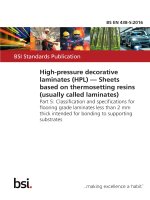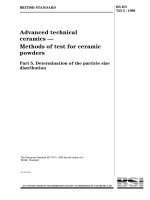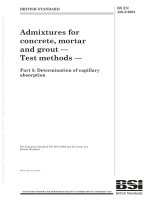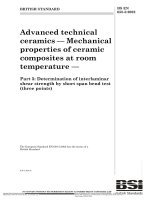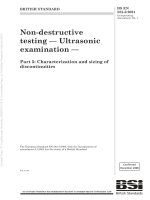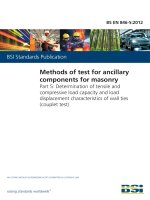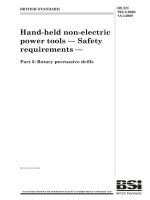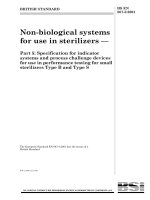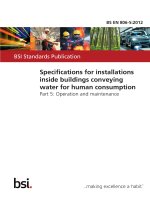Bsi bs en 61158 5 20 2014
Bạn đang xem bản rút gọn của tài liệu. Xem và tải ngay bản đầy đủ của tài liệu tại đây (2.06 MB, 60 trang )
BS EN 61158-5-20:2014
BSI Standards Publication
Industrial communication
networks — Fieldbus
specifications
Part 5-20: Application layer service
definition — Type 20 elements
BRITISH STANDARD
BS EN 61158-5-20:2014
National foreword
This British Standard is the UK implementation of EN 61158-5-20:2014. It is
identical to IEC 61158-5-20:2014. It supersedes BS EN 61158-5-20:2012
which is withdrawn.
The UK participation in its preparation was entrusted to Technical Committee AMT/7, Industrial communications: process measurement and
control, including fieldbus.
A list of organizations represented on this committee can be obtained on
request to its secretary.
This publication does not purport to include all the necessary provisions of
a contract. Users are responsible for its correct application.
© The British Standards Institution 2014.
Published by BSI Standards Limited 2014
ISBN 978 0 580 79462 9
ICS 25.040.40; 35.100.70; 35.110
Compliance with a British Standard cannot confer immunity from
legal obligations.
This British Standard was published under the authority of the
Standards Policy and Strategy Committee on 31 October 2014.
Amendments issued since publication
Date
Text affected
BS EN 61158-5-20:2014
EUROPEAN STANDARD
EN 61158-5-20
NORME EUROPÉENNE
EUROPÄISCHE NORM
October 2014
ICS 25.040.40; 35.100.70; 35.110
Supersedes EN 61158-5-20:2012
English Version
Industrial communication networks - Fieldbus specifications Part 5-20: Application layer service definition - Type 20 elements
(IEC 61158-5-20:2014)
Réseaux de communication industriels - Spécifications des
bus de terrain - Partie 5-20: Définition des services de la
couche application - Eléments de type 20
(CEI 61158-5-20:2014)
Industrielle Kommunikationsnetze - Feldbusse Teil 5-20: Dienstfestlegungen des Application Layer
(Anwendungsschicht) - Typ 20-Elemente
(IEC 61158-5-20:2014)
This European Standard was approved by CENELEC on 2014-09-22. CENELEC members are bound to comply with the CEN/CENELEC
Internal Regulations which stipulate the conditions for giving this European Standard the status of a national standard without any alteration.
Up-to-date lists and bibliographical references concerning such national standards may be obtained on application to the CEN-CENELEC
Management Centre or to any CENELEC member.
This European Standard exists in three official versions (English, French, German). A version in any other language made by translation
under the responsibility of a CENELEC member into its own language and notified to the CEN-CENELEC Management Centre has the
same status as the official versions.
CENELEC members are the national electrotechnical committees of Austria, Belgium, Bulgaria, Croatia, Cyprus, the Czech Republic,
Denmark, Estonia, Finland, Former Yugoslav Republic of Macedonia, France, Germany, Greece, Hungary, Iceland, Ireland, Italy, Latvia,
Lithuania, Luxembourg, Malta, the Netherlands, Norway, Poland, Portugal, Romania, Slovakia, Slovenia, Spain, Sweden, Switzerland,
Turkey and the United Kingdom.
European Committee for Electrotechnical Standardization
Comité Européen de Normalisation Electrotechnique
Europäisches Komitee für Elektrotechnische Normung
CEN-CENELEC Management Centre: Avenue Marnix 17, B-1000 Brussels
© 2014 CENELEC All rights of exploitation in any form and by any means reserved worldwide for CENELEC Members.
Ref. No. EN 61158-5-20:2014 E
BS EN 61158-5-20:2014
EN 61158-5-20:2014
-2-
Foreword
The text of document 65C/763/FDIS, future edition 3 of IEC 61158-5-20, prepared by
SC 65C “Industrial networks” of IEC/TC 65 “Industrial-process measurement, control and automation"
was submitted to the IEC-CENELEC parallel vote and approved by CENELEC as
EN 61158-5-20:2014.
The following dates are fixed:
•
latest date by which the document has to be
implemented at national level by
publication of an identical national
standard or by endorsement
(dop)
2015-06-22
•
latest date by which the national
standards conflicting with the
document have to be withdrawn
(dow)
2017-09-22
This document supersedes EN 61158-5-20:2012.
Attention is drawn to the possibility that some of the elements of this document may be the subject of
patent rights. CENELEC [and/or CEN] shall not be held responsible for identifying any or all such
patent rights.
This document has been prepared under a mandate given to CENELEC by the European Commission
and the European Free Trade Association.
Endorsement notice
The text of the International Standard IEC 61158-5-20:2014 was approved by CENELEC as a
European Standard without any modification.
In the official version, for Bibliography, the following notes have to be added for the standards indicated:
IEC 61158-6-20
NOTE
Harmonized as EN 61158-6-20.
IEC 61784-1
NOTE
Harmonized as EN 61784-1.
IEC 61784-2
NOTE
Harmonized as EN 61784-2.
BS EN 61158-5-20:2014
EN 61158-5-20:2014
-3-
Annex ZA
(normative)
Normative references to international publications
with their corresponding European publications
The following documents, in whole or in part, are normatively referenced in this document and are
indispensable for its application. For dated references, only the edition cited applies. For undated
references, the latest edition of the referenced document (including any amendments) applies.
NOTE 1 When an International Publication has been modified by common modifications, indicated by (mod), the relevant
EN/HD applies.
NOTE 2 Up-to-date information on the latest versions of the European Standards listed in this annex is available here:
www.cenelec.eu
Publication
Year
Title
EN/HD
Year
IEC 61158-1
2014
Industrial communication networks Fieldbus specifications Part 1: Overview and guidance for the
IEC 61158 and IEC 61784 series
EN 61158-1
2014
IEC 62591
2010
Industrial communication networks Wireless communication network
and communication profiles TM
WirelessHART
EN 62591
2010
ISO/IEC 7498-1
-
Information technology - Open Systems
Interconnection - Basic reference model:
The basic model
-
-
ISO/IEC 8824-1
-
Information technology - Abstract Syntax
Notation One (ASN.1): Specification of
basic notation
-
-
ISO/IEC 8859-1
-
Information technology - 8-bit single-byte
coded graphic character sets Part-1: Latin alphabet No. 1
-
-
ISO/IEC 9545
-
Information technology - Open Systems
Interconnection - Application layer
structure
-
-
ISO/IEC 10731
-
Information technology - Open Systems
Interconnection - Basic Reference Model Conventions for the definition of OSI
services
-
IEEE 754
-
IEEE Standard for Floating-Point
Arithmetic
-
-
BS EN 61158-5-20:2014
–2–
IEC 61158-5-20:2014 © IEC 2014
CONTENTS
INTRODUCTION ..................................................................................................................... 5
1
Scope ............................................................................................................................... 6
2
Normative references ....................................................................................................... 6
3
Terms, definitions, symbols, abbreviations and conventions ............................................. 7
4
3.1 Terms and definitions from other ISO/IEC standards ............................................... 7
3.2 IEC 61158-1 terms .................................................................................................. 8
3.3 Type 20 fieldbus application-layer specific definitions ............................................ 10
3.4 Abbreviations and symbols .................................................................................... 12
3.5 Conventions .......................................................................................................... 13
Concepts ........................................................................................................................ 16
5
Data type ASE ................................................................................................................ 16
6
5.1 Overview ............................................................................................................... 16
5.2 Formal definition of data type objects .................................................................... 18
5.3 FAL defined data types .......................................................................................... 20
5.4 Data type ASE service specification ...................................................................... 23
5.5 Summary of data types .......................................................................................... 24
Communication model specification ................................................................................ 24
6.1 Common parameters ............................................................................................. 24
6.2 ASEs ..................................................................................................................... 25
6.3 ARs ....................................................................................................................... 52
6.4 Summary of classes .............................................................................................. 54
6.5 Permitted services by AREP role ........................................................................... 55
Bibliography .......................................................................................................................... 56
Figure 1 – Data type class hierarchy ..................................................................................... 17
Figure 2 – VFD model ........................................................................................................... 25
Table 1 – Packed ASCII character set ................................................................................... 23
Table 2 – ISO Latin-1 characters .......................................................................................... 23
Table 3 – Data type summary ............................................................................................... 24
Table 4 – Response code values .......................................................................................... 24
Table 5 – Communication status values ................................................................................ 25
Table 6 – Identify service parameters ................................................................................... 28
Table 7 – Read service parameters ....................................................................................... 32
Table 8 – Write service parameters ....................................................................................... 33
Table 9 – Information report parameters ............................................................................... 34
Table 10 – Action service parameters ................................................................................... 36
Table 11 – AR get attributes service parameters ................................................................... 53
Table 12 – AR set attributes service parameters ................................................................... 54
Table 13 – Class summary .................................................................................................... 55
Table 14 – Confirmed services by AREP class ...................................................................... 55
Table 15 – Unconfirmed services by AREP class .................................................................. 55
BS EN 61158-5-20:2014
IEC 61158-5-20:2014 © IEC 2014
–5–
INTRODUCTION
This document is one of a series produced to facilitate the interconnection of automation
system components. It is related to other documents in the set as defined by the “three-layer”
fieldbus reference model described in IEC 61158-1.
The application service is provided by the application protocol making use of the services
available from the data-link or other immediately lower layer. This document defines the
application service characteristics that fieldbus applications and/or system management may
exploit.
Throughout the set of fieldbus standards, the term “service” refers to the abstract capability
provided by one layer of the OSI Basic Reference Model to the layer immediately above.
Thus, the application layer service defined in this document is a conceptual architectural
service, independent of administrative and implementation divisions.
BS EN 61158-5-20:2014
–6–
IEC 61158-5-20:2014 © IEC 2014
INDUSTRIAL COMMUNICATION NETWORKS –
FIELDBUS SPECIFICATIONS –
Part 5-20: Application layer service definition –
1
Scope
The fieldbus application layer (FAL) provides user programs with a means to access the
fieldbus communication environment. In this respect, the FAL can be viewed as a “window
between corresponding application programs.”
This International Standard provides common elements for basic time-critical and non-timecritical messaging communications between application programs in an automation
environment and material specific to Type 20 fieldbus. The term “time-critical” is used to
represent the presence of a time-window, within which one or more specified actions are
required to be completed with some defined level of certainty. Failure to complete specified
actions within the time window risks failure of the applications requesting the actions, with
attendant risk to equipment, plant and possibly human life.
This International Standard defines in an abstract way the externally visible service provided
by the Type 20 fieldbus Application Layer in terms of
a) an abstract model for defining application resources (objects) capable of being
manipulated by users via the use of the FAL service,
b) the primitive actions and events of the service;
c) the parameters associated with each primitive action and event, and the form which they
take; and
d) the interrelationship between these actions and events, and their valid sequences.
The purpose of this International Standard is to define the services provided to
the
FAL
user at the boundary between the user and the Application Layer of the Fieldbus Reference
Model.
This International Standard specifies the structure and services of the IEC fieldbus Application
Layer, in conformance with the OSI Basic Reference Model (ISO/IEC 7498-1) and the OSI
Application Layer Structure (ISO/IEC 9545).
Although these services specify, from the perspective of applications, how request and
responses are issued and delivered, they do not include a specification of what the requesting
and responding applications are to do with them. That is, the behavioral aspects of the
applications are not specified; only a definition of what requests and responses they can
send/receive is specified. This permits greater flexibility to the FAL users in standardizing
such object behavior. In addition to these services, some supporting services are also defined
in this International Standard to provide access to the FAL to control certain aspects of its
operation.
2
Normative references
The following documents, in whole or in part, are normatively referenced in this document and
are indispensable for its application. For dated references, only the edition cited applies. For
undated references, the latest edition of the referenced document (including any
amendments) applies.
BS EN 61158-5-20:2014
IEC 61158-5-20:2014 © IEC 2014
–7–
NOTE All parts of the IEC 61158 series, as well as IEC 61784-1 and IEC 61784-2 are maintained simultaneously.
Cross-references to these documents within the text therefore refer to the editions as dated in this list of normative
references.
IEC 61158-1:2014, Industrial communication networks – Fieldbus specifications – Part 1:
Overview and guidance for the IEC 61158 and IEC 61784 series
IEC 62591:2010, Industrial communication networks – Wireless communication network and
communication profiles – WirelessHART™
ISO/IEC 7498-1, Information technology – Open Systems Interconnection – Basic Reference
Model: The Basic Model
ISO/IEC 8824-1, Information
Specification of basic notation
technology
–
Abstract
Syntax
Notation
One
(ASN.1):
ISO/IEC 8859-1, Information technology – 8-bit single-byte coded graphic character sets –
Part 1: Latin alphabet No. 1
ISO/IEC 9545, Information technology – Open Systems Interconnection – Application Layer
structure
ISO/IEC 10731, Information technology – Open Systems Interconnection – Basic Reference
Model – Conventions for the definition of OSI services
ANSI/IEEE 754: IEEE Standard for Floating-Point Arithmetic
3
Terms, definitions, symbols, abbreviations and conventions
For the purposes of this document, the following terms, definitions, abbreviations, symbols
and conventions apply.
3.1
Terms and definitions from other ISO/IEC standards
3.1.1
ISO/IEC 7498-1 terms
a) abstract syntax
b) application entity
c) application process
d) application protocol data unit
e) application service element
3.1.2
ISO/IEC 9545 terms
a) application-entity-invocation
b) application-service-element
c) application-service-element
3.1.3
ISO/IEC 8824-1 terms
a) object identifier
b) type
c) value
d) simple type
e) structured type
f)
component type
BS EN 61158-5-20:2014
–8–
IEC 61158-5-20:2014 © IEC 2014
g) tag
h) true
i)
false
j)
integer type
k) octet string type
m) null type
3.2
IEC 61158-1 terms
For the purposes of this document, the following terms and definitions apply.
3.2.1
application
function or data structure for which data is consumed or produced
3.2.2
application object
object class that manages and provides the run time exchange of messages across the
network and within the network device
Note 1 to entry: Multiple types of application object classes may be defined.
3.2.3
application process
part of a distributed application on a network, which is located on one device and
unambiguously addressed
3.2.4
application process object
component of an application process that is identifiable and accessible through an FAL
application relationship
Note 1 to entry: Application process object definitions are composed of a set of values for the attributes of their
class (see the definition for Application Process Object Class Definition). Application process object definitions may
be accessed remotely using the services of the FAL Object Management ASE. FAL Object Management services
can be used to load or update object definitions, to read object definitions, and to dynamically create and delete
application objects and their corresponding definitions
3.2.5
application process object class
class of application process objects defined in terms of the set of their network-accessible
attributes and services
3.2.6
application relationship
cooperative association between two or more application-entity-invocations for the purpose of
exchange of information and coordination of their joint operation
Note 1 to entry: This relationship is activated either by the exchange of application-protocol-data-units or as a
result of pre-configuration activities
3.2.7
application relationship endpoint
context and behavior of an application relationship as seen and maintained by one of the
application processes involved in the application relationship
Note 1 to entry: Each application process involved in the application relationship maintains its own application
relationship endpoint
BS EN 61158-5-20:2014
IEC 61158-5-20:2014 © IEC 2014
–9–
3.2.8
attribute
description of an externally visible characteristic or feature of an object
Note 1 to entry: The attributes of an object contain information about variable portions of an object. Typically, they
provide status information or govern the operation of an object. Attributes may also affect the behaviour of an
object. Attributes are divided into class attributes and instance attributes
3.2.9
behaviour
indication of how the object responds to particular events
Note 1 to entry:
Its description includes the relationship between attribute values and services.
3.2.10
class
set of objects, all of which represent the same kind of system component
Note 1 to entry: A class is a generalisation of the object; a template for defining variables and methods. All
objects in a class are identical in form and behaviour, but usually contain different data in their attributes
3.2.11
class attributes
attribute that is shared by all objects within the same class
3.2.12
class code
unique identifier assigned to each object class
3.2.13
class specific service
service defined by a particular object class to perform a required function which is not
performed by a common service
Note 1 to entry:
A class specific object is unique to the object class which defines it.
3.2.14
client
a) an object which uses the services of another (server) object to perform a task
b)
an initiator of a message to which a server reacts, such as the role of an AR endpoint in
which it issues confirmed service request APDUs to a single AR endpoint acting as a
server
3.2.15
conveyance path
unidirectional flow of APDUs across an application relationship
3.2.16
cyclic
term used to describe events which repeat in a regular and repetitive manner
3.2.17
endpoint
one of the communicating entities involved in a connection
3.2.18
error
discrepancy between a computed, observed or measured value or condition and the specified
or theoretically correct value or condition
BS EN 61158-5-20:2014
– 10 –
IEC 61158-5-20:2014 © IEC 2014
3.2.19
error code
identification of a specific type of error within an error class
3.2.20
management information
network-accessible information that supports managing the operation of the fieldbus system,
including the application layer
Note 1 to entry:
Managing includes functions such as controlling, monitoring, and diagnosing.
3.2.21
server
a) role of an AREP in which it returns a confirmed service response APDU to the client that
initiated the request
b)
an object which provides services to another (client) object
3.2.22
service
operation or function than an object and/or object class performs upon request from another
object and/or object class
Note 1 to entry: A set of common services is defined and provisions for the definition of object-specific services
are provided. Object-specific services are those which are defined by a particular object class to perform a required
function which is not performed by a common service.
3.3
Type 20 fieldbus application-layer specific definitions
For the purposes of this document, the following terms and definitions apply.
3.3.1
analog channel
continuously varying electrical signal connecting a field device to the remainder of the data
acquisition or control system
Note 1 to entry: Some field devices support multiple analog channels (input or output). Each analog channel
transmits a single dynamic variable to or from the field device.
3.3.2
broadcast
process of sending a PDU to all devices that are connected to the network and are able to
receive the transmission
3.3.3
broadcast address
address used by a master to send a command to all devices
3.3.4
burst mode
initiation of communication activity by a slave device at cyclic interval without request from a
master
3.3.5
comm error
detectable error in receiving a PhPDU or DLPDU, also ‘Communication error code’ octet of
APDU
BS EN 61158-5-20:2014
IEC 61158-5-20:2014 © IEC 2014
– 11 –
3.3.6
device
any entity containing an implementation of Type 20 fieldbus
3.3.7
device ID
serial number for a device that is unique among all instances of one type of device
Note 1 to entry: The manufacturer is required to assigned unique value for every device that has the identical
values for Manufacturer ID and Device Type.
3.3.8
device type
manufacturer’s type of a device, e.g. its product name
Note 1 to entry: The value of this attribute is unique among all manufacturers and all type of devices. Its value
specifies the set of commands and data objects supported by the device.
3.3.9
device variable
uniquely defined data item within a Field Device that is always associated with the processrelated information
Note 1 to entry: A device variable's value varies in response to changes and variations in the process to which the
device is connected.
3.3.10
dynamic variable
device variable that is assigned as the dynamic variable and possibly associated with an
analog channel
Note 1 to entry: A device may contain up to four variables – primary, secondary, tertiary, and quaternary
variables. These are collectively called the dynamic variables.
3.3.11
expanded device type
manufacturer’s type of the device
Note 1 to entry: The value of this attribute is unique among all manufacturers and all type of devices. Its value
specifies the set of commands and data objects supported by the device.
3.3.12
field device
physical entity that is connected to the process or to plant equipment and has at least one
signalling element that communicates with other signalling element(s) via the network
Note 1 to entry: It directly connects to the sensor or actuator or performs process control function and it is directly
connected to the physical layer specified in this standard. It may generate or receive an analog signal in addition to
a digital signal.
3.3.13
long tag
32 character restricted ISO Latin-1 string used to identify a field device
3.3.14
loop current
value measured by a milli-ammeter in series with the field device
Note 1 to entry: The loop current is a near DC analog 4-20 mA signal used to communicate a single value
between the control system and the field device. Voltage mode devices use "Volts DC" as their engineering units
where "loop current" values are used.
BS EN 61158-5-20:2014
– 12 –
IEC 61158-5-20:2014 © IEC 2014
3.3.15
manufacturer ID
string identifying the manufacturer that produced the device
Note 1 to entry: A manufacturer is required to use the value assigned to it and is not permitted to use the value
assigned to another manufacturer.
3.3.16
master
device that initiates communication activity by sending request PDU to a another device and
expecting a response frame from that device
3.3.17
network
single pair of cable, connectors, associated signaling elements by which a given set of
signaling devices are interconnected and non-signaling elements that are attached to the
same pair of cable
Note 1 to entry: An installation using multiple-pair wire and a common network power supply is considered as
multiple networks.
3.3.18
polling address
identifier assigned to a device such that it is unique within the network to which the device is
connected
3.3.19
slave
device that initiates communication activity only after it receives a request PDU from a master
device and it is required to send a response to that request
3.3.20
tag
8 character ASCII string used to identify the field device
3.3.21
unique ID
identifier assigned to a device which is unique among all instances of the devices compliant to
this standard
3.4
Abbreviations and symbols
AE
Application Entity
AL
Application Layer
AP
Application Process
APDU
Application Protocol Data Unit
APO
Application Process Object
AR
Application Relationship
AREP
Application Relationship End Point
ASCII
American Standard Code for Information Interchange
ASE
Application Service Element
Cnf
Confirmation
DL-
(as a prefix) Data Link-
DLC
Data Link Connection
DLL
Data Link Layer
BS EN 61158-5-20:2014
IEC 61158-5-20:2014 © IEC 2014
– 13 –
DLM
Data Link-management
DLSAP
Data Link Service Access Point
DLSDU
DL-service-data-unit
FAL
Fieldbus Application Layer
ID
Identifier
IEC
International Electrotechnical Commission
Ind
Indication
OSI
Open Systems Interconnect
Req
Request
Rsp
Response
VFD
Virtual Field Device
3.5
3.5.1
Conventions
Overview
The FAL is defined as a set of object-oriented ASEs. Each ASE is specified in a separate
subclause. Each ASE specification is composed of two parts, its class specification, and its
service specification.
The class specification defines the attributes of the class. The service specification defines
the services that are provided by the ASE.
3.5.2
Conventions for class definitions
Class definitions are described using templates. Each template consists of a list of attributes
for the class. The general form of the template is shown below:
FAL ASE:
ASE Name
CLASS:
CLASS ID:
PARENT CLASS:
ATTRIBUTES:
1
(o)
Key Attribute:
2
(o)
Key Attribute:
3
(m) Attribute:
4
(m) Attribute:
4.1
(s)
Attribute:
4.2
(s)
Attribute:
4.3
(s)
Attribute:
5.
(c)
Constraint:
5.1
(m) Attribute:
5.2
(o)
Attribute:
6
(m) Attribute:
6.1
(s)
Attribute:
6.2
(s)
Attribute:
SERVICES:
1
(o)
OpsService:
2.
(c)
Constraint:
2.1
(o)
OpsService:
3
(m) MgtService:
Class Name
#
Parent Class Name
numeric identifier
name
attribute name(values)
attribute name(values)
attribute name(values)
attribute name(values)
attribute name(values)
constraint expression
attribute name(values)
attribute name(values)
attribute name(values)
attribute name(values)
attribute name(values)
service name
constraint expression
service name
service name
(1) The "FAL ASE:" entry is the name of the FAL ASE that provides the services for the class
being specified.
BS EN 61158-5-20:2014
– 14 –
IEC 61158-5-20:2014 © IEC 2014
(2) The "CLASS:" entry is the name of the class being specified. All objects defined using
this template will be an instance of this class. The class may be specified by this
standard, or by a user of this standard.
(3) The "CLASS ID:" entry is a number that identifies the class being specified. This number
is unique within the FAL ASE that will provide the services for this class. When qualified
by the identity of its FAL ASE, it unambiguously identifies the class within the scope of
the FAL. The value "NULL" indicates that the class cannot be instantiated. The CLASS ID
is not used in this document.
(4) The "PARENT CLASS:" entry is the name of the parent class for the class being
specified. All attributes defined for the parent class and inherited by it are inherited for
the class being defined, and therefore do not have to be redefined in the template for this
class.
NOTE The parent-class "TOP" indicates that the class being defined is an initial class definition. The parent
class TOP is used as a starting point from which all other classes are defined. The use of TOP is reserved for
classes defined by this document.
(5) The "ATTRIBUTES" label indicate that the following entries are attributes defined for the
class.
a)
Each of the attribute entries contains a line number in column 1, a mandatory (m) /
optional (o) / conditional (c) / selector (s) indicator in column 2, an attribute type label
in column 3, a name or a conditional expression in column 4, and optionally a list of
enumerated values in column 5. In the column following the list of values, the default
value for the attribute may be specified.
b)
Objects are normally identified by a numeric identifier or by an object name, or by
both. In the class templates, these key attributes are defined under the key attribute.
c)
The line number defines the sequence and the level of nesting of the line. Each
nesting level is identified by period. Nesting is used to specify
i)
fields of a structured attribute (4.1, 4.2, 4.3),
ii)
attributes conditional on a constraint statement (5). Attributes may be mandatory
(5.1) or optional (5.2) if the constraint is true. Not all optional attributes require
constraint statements as does the attribute defined in (5.2).
iii)
the selection fields of a choice type attribute (6.1 and 6.2).
(6) The "SERVICES" label indicates that the following entries are services defined for the
class.
a)
An (m) in column 2 indicates that the service is mandatory for the class, while an (o)
indicates that it is optional. A (c) in this column indicates that the service is
conditional. When all services defined for a class are defined as optional, at least
one has to be selected when an instance of the class is defined.
b)
The label "OpsService" designates an operational service.
c)
The label "MgtService" designates an management service.
d)
The line number defines the sequence and the level of nesting of the line. Each
nesting level is identified by period. Nesting within the list of services is used to
specify services conditional on a constraint statement.
3.5.3
3.5.3.1
Conventions for service definitions
General
This document uses the descriptive conventions given in ISO/IEC 10731.
The service model, service primitives, and time-sequence diagrams used are entirely abstract
descriptions; they do not represent a specification for implementation.
BS EN 61158-5-20:2014
IEC 61158-5-20:2014 © IEC 2014
3.5.3.2
– 15 –
Service parameters
Service primitives are used to represent service user/service provider interactions
(ISO/IEC 10731). They convey parameters which indicate information available in the
user/provider interaction.
This document uses a tabular format to describe the component parameters of the service
primitives. The parameters that apply to each group of service primitives are set out in tables
throughout the remainder of this document. Each table consists of up to six columns: a
column for the name of the service parameter, and a column each for those primitives and
parameter-transfer directions used by the service. The possible six columns are
1) the parameter name;
2) the request primitive’s input parameters;
3) the request primitive’s output parameters;
NOTE 1 This is a seldom-used capability. Unless otherwise specified, request primitive parameters are input
parameters.
4) the indication primitive’s output parameters;
5) the response primitive’s input parameters; and
6) the confirm primitive’s output parameters.
NOTE 2 The request, indication, response and confirm primitives are also known as requestor.submit,
acceptor.deliver, acceptor.submit, and requestor.deliver primitives, respectively (see ISO/IEC 10731).
One parameter (or component of it) is listed in each row of each table. Under the appropriate
service primitive columns, a code is used to specify the type of usage of the parameter on the
primitive specified in the column:
M
parameter is mandatory for the primitive
U
parameter is a User option, and may or may not be provided depending on dynamic
usage of the service user. When not provided, a default value for the parameter is
assumed.
C
parameter is conditional upon other parameters or upon the environment of the service
user.
—
(blank) parameter is never present.
S
parameter is a selected item.
Some entries are further qualified by items in brackets. These may be
a)
a parameter-specific constraint:
“(=)” indicates that the parameter is semantically equivalent to the parameter in the
service primitive to its immediate left in the table.
b)
an indication that some note applies to the entry:
“(n)” indicates that the following note "n" contains additional information pertaining to
the parameter and its use.
3.5.3.3
Service procedures
The procedures are defined in terms of
–
the interactions between application entities through the exchange of fieldbus Application
Protocol Data Units, and
–
the interactions between an application layer service provider and an application layer
service user in the same system through the invocation of application layer service
primitives.
These procedures are applicable to instances of communication between systems which
support time-constrained communications services within the fieldbus Application Layer.
BS EN 61158-5-20:2014
– 16 –
IEC 61158-5-20:2014 © IEC 2014
NOTE The IEC 61158-5 subseries define sets of abstract services. They are neither protocol specifications nor
implementation specifications nor concrete programming interface specifications. Therefore there are restrictions
on the extent to which service procedures can be mandated in the parts of IEC 61158-5 subseries. Protocol
aspects that can vary among different protocol specifications or different implementations that instantiate the same
abstract services are unsuitable for inclusion in these service definitions, except at the level of abstraction that is
necessarily common to all such expressions.
For example, the means by which service providers pair request and reply PDUs is appropriate for specification in
an IEC 61158-6 subseries protocol specification document but not in an IEC 61158-5 subseries abstract service
definition document. Similarly, local implementation methods by which a service provider or service user pairs
request and confirm(ation) primitives, or indication and response primitives, is appropriate for an implementation
specification or for a programming interface specification, but not for an abstract service document or for a protocol
document, except at a level of abstraction that is necessarily common to all embodiments of the specifying
document. In all cases, the abstract definition is not permitted to over-specify the more concrete instantiating
realization.
Further information on the conceptual service procedures of an implementation of a protocol that realizes the
services of one of the IEC 61158-5 subseries abstract service definitions can be found in IEC 61158-1, 9.6.
4
Concepts
The common concepts and templates used to describe the application layer service in this
document are detailed in IEC 61158-1, Clause 9.
5
Data type ASE
5.1
5.1.1
Overview
General
Fieldbus data types specify the machine independent syntax for application data conveyed by
FAL services. The Fieldbus application layer supports the definition and transfer of both basic
and constructed data types. Encoding rules for the data types specified in this clause are
provided in IEC 61158-6 subseries.
Basic types are atomic types that cannot be decomposed into more elemental types.
Constructed types are types composed of basic types and other constructed types. Their
complexity and depth of nesting is not constrained by this document.
Data types are defined as instances of the data type class, as shown in Figure 1.
BS EN 61158-5-20:2014
IEC 61158-5-20:2014 © IEC 2014
– 17 –
Data type
Basic type
Integer8
Integer16
Integer24
Integer32
String
Structure
Array
Packed ASCII
ISO Latin-1
Unsigned8
Unsigned 16
Unsigned 24
Unsigned 32
Float32
Float64
Date
Enumeration
Bit Field
Time
Engineering unit
Figure 1 – Data type class hierarchy
The data type definitions are represented as a class/format/instance structure beginning with
data type class entitled "Data type". The formats for data types are defined by the data type
class.
The basic data classes are always fixed length data types. Standard types taken from
ISO/IEC 8824-1 are referred to as simple data types. Other standard basic data types are
defined specifically for Fieldbus applications and are referred to as specific types.
The constructed types specified in this document are strings, arrays and structures. There are
no standard types defined for arrays and structures.
5.1.2
Basic types
Most basic types are defined from a set of ISO/IEC 8824-1 types (simple types). Some
ISO/IEC 8824-1 types have been extended for Fieldbus specific use (specific types).
Simple types are ISO/IEC 8824-1 universal types. They are defined in this document to
provide them with Fieldbus class identifiers.
Specific types are basic types defined specifically for use in the Fieldbus environment. They
are defined as simple class subtypes.
BS EN 61158-5-20:2014
– 18 –
IEC 61158-5-20:2014 © IEC 2014
Basic types have a constant length. Two variations are defined, one for defining data types
whose length is an integral number of octets, and one for defining data types whose length is
bits.
NOTE Integer, Packed ASCII, ISO Latin-1 and Date are defined in this document for the purpose of assigning
Fieldbus class identifiers to them. This document does not change their definitions as specified in ISO/IEC 8824-1.
5.1.3
Constructed types
5.1.3.1
Overview
Constructed data types are needed to completely convey the variety of information present on
the Fieldbus. There are three kinds of constructed types defined for this document – string,
array and structure.
5.1.3.2
String
A string is composed of an ordered set, variable in number, of homogeneously typed fixedlength elements.
5.1.3.3
Structure
A structure is made of an ordered set of heterogeneously typed elements called fields. This
document does not restrict the data type of fields. However, the fields within a structure do not
have to be of the same type.
5.1.3.4
Array
An array is composed of an ordered set of homogeneously typed elements. The data type of
array elements can be fixed length basic type or structure. All elements of an array shall be of
the same type.
5.1.3.5
Nesting level
This document permits structures and arrays to contain structures and arrays.
5.1.4
Specification of user defined data types
Users may find it necessary to define custom data types for their own applications. User
defined types are not supported by this document.
5.1.5
Transfer of user data
User data is transferred between applications by the FAL protocol. All encoding and decoding
are performed by the FAL user.
The rules for encoding user data in FAL protocol data units is data type dependent. These
rules are defined in IEC 61158-6-20. User-defined data types for which there are no encoding
rules are transferred as a variable-length sequence of octets. The format of the data within
the octet string is defined by the user.
5.2
5.2.1
Formal definition of data type objects
Data type class
The data type class specifies the root of the data type class tree. Its parent class "top"
indicates the top of the FAL class tree.
FAL ASE:
CLASS:
DATA TYPE ASE
DATA TYPE
BS EN 61158-5-20:2014
IEC 61158-5-20:2014 © IEC 2014
– 19 –
CLASS ID:
Not used
PARENT CLASS:
ATTRIBUTES:
TOP
1
2
3
3.1
4
4.1
4.2
4.2.1
4.2.2
5
5.1
5.2
Data type Name
Format (FIXED LENGTH, STRING, STRUCTURE, ARRAY)
Format = FIXED LENGTH | STRING
Octet Length
Format = STRUCTURE
Number of Fields
List of Fields
Field Name
Field Data type
Format = ARRAY
Number of Array Elements
Array Element Data type
5.2.2
(m)
(m)
(c)
(m)
(c)
(m)
(m)
(o)
(m)
(c)
(m)
(m)
Key Attribute:
Attribute:
Constraint:
Attribute:
Constraint:
Attribute:
Attribute:
Attribute:
Attribute:
Constraint:
Attribute:
Attribute :
Attributes
Format
This attribute identifies the data type as a fixed-length, string, array, or data structure.
Octet Length
This conditional attribute defines the representation of the dimensions of the associated type
object. It is present when the value of the format attribute is "FIXED LENGTH" or "STRING".
For FIXED LENGTH data types, it represents the length in octets. For STRING data types, it
represents the length in octets for a single element of a string.
Number of Fields
This conditional attribute defines the number of fields in a structure. It is present when the
value of the format attribute is "STRUCTURE".
List of Fields
This conditional attribute is an ordered list of fields contained in the structure. Each field is
specified by its number and its type. Fields are numbered sequentially from 0 (zero) in the
order in which they occur. Partial access to fields within a structure is not supported.
Field Name
This conditional, optional attribute specifies the name of the field. It may be present when the
value of the format attribute is "STRUCTURE".
Field Data type
This conditional attribute specifies the data type of the field. It is present when the value of
the format attribute is "STRUCTURE". This attribute may itself specify a constructed data type
by referencing a constructed data type definition by embedding a constructed data type
definition here.
Number of Array Elements
This conditional attribute defines the number of elements for the array type. Array elements
are indexed starting at “0” through “n-1” where the size of the array is “n” elements. This
attribute is present when the value of the format attribute is "ARRAY".
Array Element Data type
This conditional attribute specifies the data type for the elements of an array. All elements of
the array have the same data type. It is present when the value of the format attribute is
"ARRAY". This attribute may itself specify a constructed data type by referencing a
constructed data type by its name.
BS EN 61158-5-20:2014
– 20 –
5.3
IEC 61158-5-20:2014 © IEC 2014
FAL defined data types
5.3.1
5.3.1.1
Fixed length types
Integer8
CLASS:
ATTRIBUTES:
Data type
1
2
2.1
=
=
=
Data type Name
Format
Octet Length
Integer8
FIXED LENGTH
1
This integer type is a two’s complement binary number with a length of one octet.
5.3.1.2
Integer16
CLASS:
ATTRIBUTES:
Data type
1
2
2.1
=
=
=
Data type Name
Format
Octet Length
Integer16
FIXED LENGTH
2
This integer type is a two’s complement binary number with a length of two octets.
5.3.1.3
Integer24
CLASS:
ATTRIBUTES:
Data type
1
2
2.1
=
=
=
Data type Name
Format
Octet Length
Integer24
FIXED LENGTH
3
This integer type is a two’s complement binary number with a length of three octets.
5.3.1.4
Integer32
CLASS:
ATTRIBUTES:
Data type
1
2
2.1
=
=
=
Data type Name
Format
Octet Length
Integer32
FIXED LENGTH
4
This integer type is a two’s complement binary number with a length of four octets.
5.3.1.5
Unsigned8
CLASS:
ATTRIBUTES:
Data type
1
2
2.1
=
=
=
Data type Name
Format
Octet Length
Unsigned8
FIXED LENGTH
1
This type is a binary number. The most significant bit of the most significant octet is always
used as the most significant bit of the binary number; no sign bit is included. This type has a
length of one octet.
5.3.1.6
Unsigned16
CLASS:
ATTRIBUTES:
Data type
1
=
Data type Name
Unsigned16
BS EN 61158-5-20:2014
IEC 61158-5-20:2014 © IEC 2014
2
2.1
Format
Octet Length
=
=
– 21 –
FIXED LENGTH
2
This type is a binary number. The most significant bit of the most significant octet is always
used as the most significant bit of the binary number; no sign bit is included. This unsigned
type has a length of two octets.
5.3.1.7
Unsigned24
CLASS:
ATTRIBUTES:
Data type
1
2
2.1
=
=
=
Data type Name
Format
Octet Length
Unsigned24
FIXED LENGTH
3
This type is a binary number. The most significant bit of the most significant octet is always
used as the most significant bit of the binary number; no sign bit is included. This unsigned
type has a length of three octets.
5.3.1.8
Unsigned32
CLASS:
ATTRIBUTES:
Data type
1
2
2.1
=
=
=
Data type Name
Format
Octet Length
Unsigned32
FIXED LENGTH
4
This type is a binary number. The most significant bit of the most significant octet is always
used as the most significant bit of the binary number; no sign bit is included. This unsigned
type has a length of four octets.
5.3.1.9
Float32
CLASS:
ATTRIBUTES:
Data type
1
2
2.1
=
=
=
Data type Name
Format
Octet Length
Float32
FIXED LENGTH
4
This type has a length of four octets. The format for Float32 is that defined by ANSI/IEEE 754
as single precision.
5.3.1.10
Float64
CLASS:
ATTRIBUTES:
Data type
1
2
2.1
=
=
=
Data type Name
Format
Octet Length
Float64
FIXED LENGTH
8
This type has a length of eight octets. The format for Float64 is that defined by
ANSI/IEEE 754 as double precision.
5.3.1.11
Date
CLASS:
ATTRIBUTES:
Data type
1
2
2.1
=
=
=
Data type Name
Format
Octet Length
Date
FIXED LENGTH
3
BS EN 61158-5-20:2014
– 22 –
IEC 61158-5-20:2014 © IEC 2014
This data type is consists of day, month and year minus 1900. This allows the representation
of any date between 1 January 1900 and 31 December 2155.
5.3.1.12
Enumeration
CLASS:
ATTRIBUTES:
Data type
1
2
2.1
=
=
=
Data type Name
Format
Octet Length
Enumeration
FIXED LENGTH
1
Data items that take on a single meaning from a list or table are encoded as Enumeration.
This data type uses an unsigned integer of one octet length. The largest integer value is
reserved and not used by any service.
5.3.1.13
Bit Field
CLASS:
ATTRIBUTES:
Data type
1
2
2.1
=
=
=
Data type Name
Format
Octet Length
Bit Field
FIXED LENGTH
1
This data type is defined as a series of eight bits, numbered from 0 to 7. Communication of
information encoded as single-bit data (such as status and diagnostic information) uses this
data type.
5.3.1.14
Time
CLASS:
ATTRIBUTES:
Data type
1
2
2.1
=
=
=
Data type Name
Format
Octet Length
Time
FIXED LENGTH
4
This data type is an unsigned binary integer and represents time in the increments of 1/32 of
a millisecond. If this data type is used to represent time of day, then it indicates number of
1/32 of milliseconds since midnight.
5.3.1.15
Engineering unit
CLASS:
ATTRIBUTES:
Data type
1
2
2.1
=
=
=
Data type Name
Format
Octet Length
Engineering unit
FIXED LENGTH
1
This type defines the measurement unit of a measured variable. The interpretation of this data
type is specified by the communication profile and beyond the scope of this part of the
document.
5.3.2
5.3.2.1
String Types
Packed ASCII
CLASS:
ATTRIBUTES:
Data type
1
2
2.1
=
=
=
Data type Name
Format
Octet Length
Packed ASCII
STRING
1 to n
BS EN 61158-5-20:2014
IEC 61158-5-20:2014 © IEC 2014
– 23 –
This type is a modified subset of the ASCII character code set. This subset is shown in
Table 1.
Table 1 – Packed ASCII character set
Bits 4
and 5
Bits 0 to 3
0
1
2
3
4
5
6
7
8
9
A
B
C
0
1
2
3
@
P
SPa
0
NOTE
Most significant hexadecimal digit is top to bottom; least significant is left to right.
A
Q
!
1
B
R
"
2
C
S
#
3
D
T
$
4
E
U
%
5
F
V
&
6
G
W
'
7
H
X
(
8
I
Y
)
9
J
Z
*
:
K
[
+
;
L
\
,
<
D
M
]
=
E
N
^
.
>
F
O
_
/
?
a SP indicates a space character.
5.3.2.2
ISO Latin-1
CLASS:
ATTRIBUTES:
Data type
1
2
2.1
=
=
=
Data type Name
Format
Octet Length
Latin-1
STRING
1 to n
This type is a subset of the ISO/IEC 8859-1 (ISO Latin-1) string type. The subset is shown in
Table 2.
Table 2 ISO Latin-1 characters
Bits 4
to 7
0
1
2
3
4
5
6
7
8
9
A
B
C
D
E
F
Bits 0 to 3
0
1
2
3
4
5
6
7
8
9
A
B
C
D
E
F
SPa
0
@
P
`
p
!
1
A
Q
a
q
"
2
B
R
B
R
#
3
C
S
c
s
$
4
D
T
D
T
%
5
E
U
e
u
&
6
F
V
f
v
'
7
G
W
g
w
(
8
H
X
h
x
)
9
I
Y
i
y
*
:
J
Z
j
z
+
;
K
[
k
{
,
<
L
\
l
|
=
M
]
m
}
.
>
N
^
n
~
/
?
O
_
o
NBSPb
é
Ă
ẹ
ỏ
ủ
Â
ề
õ
ũ
Ê
ể
ó
ú
Ô
ễ
ễ
Ơ
à
ế
ồ
ừ
Ư
ả
ặ
ệ
ổ
ử
Đ
Ã
ầ
ì
ỗ
ữ
ă
á
ẩ
ỉ
ố
ứ
â
ạ
ẫ
ộ
ự
ê
ấ
ấ
ô
ằ
ậ
ở
ỷ
ơ
ẳ
è
ĩ
ỡ
ỹ
SHYc
ẵ
í
ớ
ý
đ
ắ
ẻ
ị
ợ
ỵ
ẽ
ò
ù
NOTE Most significant hexadecimal digit is top to bottom; least significant is left to right. Grayed out cells
means that no character is assigned to this code.
a SP indicates a space character.
b NBSP indicates a non-breaking space character.
c SHY indicates a soft hyphen.
5.4
Data type ASE service specification
There are no operational services defined for the type object.
